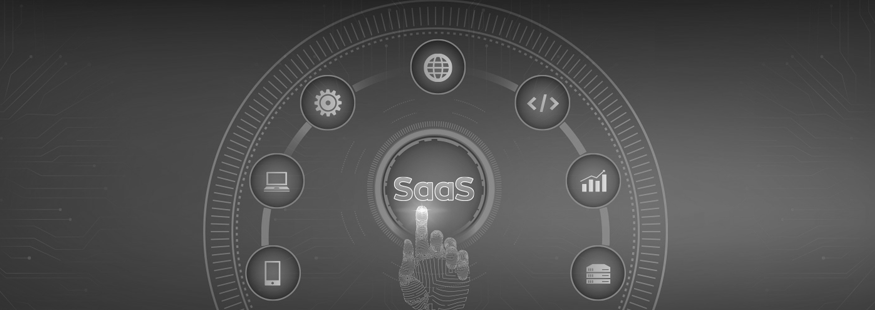Quick Summary
Software as a Service (SaaS) brought a new breed of cloud solutions, replacing bulky software installations and hefty upfront costs. And that’s why The SaaS concept quickly became one of the world’s most widely used corporate practices. Many prominent software companies, including Salesforce, Zoom, and Dropbox, use SaaS business models.
As of 2023, the software as a service (SaaS) market was estimated to be worth around 197 billion U.S. dollars. Projections indicate a continued upward trajectory, with expectations to reach an impressive 232 billion U.S. dollars by 2024.
SAAS solutions are agile, subscription-based applications quickly reshaping the software landscape. However, not all SaaS platforms reach for the skies. So, what makes certain SaaS solutions soar while others struggle to gain traction?
The blog will dissect the key ingredients that propel SaaS platforms to new heights. If you’re gearing up to launch a successful SaaS product, here are a few smart moves to keep in your back pocket.
SaaS VS Conventional software
Affordable: Unlike traditional software that requires upfront investment and installation, SaaS is typically offered on a subscription basis, making it more affordable for businesses of all sizes. Additionally, SaaS applications are hosted in the cloud, eliminating the need for complex IT infrastructure.
Scalable and Flexible: SaaS solutions are designed to scale with your business, seamlessly adapting to your changing needs. You can add or remove users and access your data from anywhere with an internet connection.
Regular updates and Innovation: SaaS providers constantly release new features and updates, ensuring your software is always up-to-date with the latest advancements. This eliminates the need for costly and time-consuming software upgrades.
Improved collaboration and communication: SaaS applications often come with built-in collaboration tools, making it easier for teams to collaborate and share information. This can lead to increased productivity and efficiency.
Enhanced Customer Support: SaaS providers typically offer excellent customer support, ensuring you get the help you need when needed.
What determines SAAS Success?
Many elements and indicators contribute to the success of a SaaS solution. These include the simplicity of installation and usage, the responsiveness of the support staff, and the adaptability of the solution to changes in site traffic.
1. Clearly Understand Your Target Market
Identify a clear and well-defined problem your SaaS product will solve for a specific target audience. The more focused your solution, the better you can cater to the needs of your users.
Conduct thorough market research to understand your target audience’s demographics, needs, and pain points. This will help you tailor your product features and messaging to resonate with them.
2. Build a Minimum Viable Product (MVP)
An MVP is your solution with just the right number of features for your audience.
Instead of aiming for a fully-fledged product launch, prioritize creating a Minimum Viable Product (MVP) that addresses the core problem for your target audience. This allows you to gather early user feedback and iterate quickly based on their needs. MVP success criteria include customer acquisition, retention, engagement, and revenue generation.
Actively solicit feedback from your early users through surveys, interviews, and beta testing. Use this feedback to refine your product and ensure it meets their needs and expectations. For instance, Instagram started as a simple photo-sharing app and iterated based on gathered user feedback.
3. Design for Usability and User Experience (UX)
Make your SaaS product easy to learn and use with a clean and intuitive interface. Users should be able to understand and navigate your product without extensive training. Pay attention to every aspect of the user experience, from onboarding to ongoing use. Strive to create a seamless and enjoyable experience that keeps users returning for more.
4. Market Effectively
Articulate the unique value proposition of your SaaS product and how it benefits your target audience. When marketing, remember the problem your product solves for the target audience. Keep your message clear for an immediate connection. This will help you attract potential customers and differentiate yourself from competitors.
Utilize a mix of marketing channels, such as content marketing, social media marketing, and paid advertising, to reach your target audience and generate leads.
5. Offer Outstanding Customer Support
Prioritize customer satisfaction. Make it easy for your customers to get help by offering multiple support channels, such as email, phone, and live chat. Go the extra mile to ensure your customers are satisfied with your product and support. Address their concerns promptly and professionally, and be proactive in providing solutions.
6. Track, Monitor and Improve
Monitor key performance indicators (KPIs) such as user engagement, churn rate, and customer satisfaction. This data will help you identify areas for improvement and track your progress over time.
Continuously seek opportunities to improve your product and stay ahead of competition. Be open to new technologies and trends, and be willing to adapt your product accordingly.
One of the prime examples is Netflix that measures product success meticulously. The metrics they use to track the results include user engagement, customer retention, and revenue generation.
Key Metrics for Measuring SaaS Success:
Measuring the success of a SaaS product involves tracking various key metrics that provide valuable insights into its performance and user satisfaction. Here are some essential metrics commonly monitored:
1. Churn Rate:
The percentage of customers who cancel or stop using the SaaS product over a specific period. High churn rates can indicate dissatisfaction or issues with the product, customer support, or market fit.
Churn Rate Formula:
Customers leaving business/total number of customers acquired *1004.
Suppose you get 100 customers, and 5 of them leave your business. So, the SaaS churn rate will be 5/100= 0.05*100= 5%.
Tips to Improve SaaS Churn Rate:
- Gather customer feedback about your service to improve and retain more customers.
- Analyze competitors and offer some unique features that your peers are not offering.
- Deliver what you have promised.
2. Net Promoter Score (NPS):
A measure of customer satisfaction based on the likelihood of users recommending the product to others. NPS helps gauge customer loyalty and satisfaction, providing insights into the product’s perceived value.
Tips to Improve NPS:
- Deliver what customers demand.
- Connect with customers personally.
- Improve based on feedback.
3. Customer Acquisition Cost (CAC):
The total cost incurred to acquire a new customer, including marketing, sales, and onboarding expenses. CAC helps evaluate the efficiency of your marketing and sales strategies for revenue generation.
CAC Formula:
CAC = Total Marketing + Sales Expenses / No. of New Customers Acquired
Tips to Improve CAC:
Optimize your digital touchpoints, web or mobile app, etc.
Boost the value proposition offered to users.
Use CRM to optimize customer relations and satisfaction.
4. Monthly Recurring Revenue (MRR):
The predictable and recurring revenue generated by the SaaS product on a monthly basis. MRR reflects the stability and growth of the subscription-based business model.
MRR Formula:
MRR = Number of customers * Payment per month
Tips to Improve MRR:
- Boost monthly customers.
- Reduce churn rate.
- Deliver solutions to their pain points.
5. Customer Lifetime Value (CLV):
The total revenue a company expects from customers throughout their relationship. CLV helps understand customers’ long-term value and guides marketing and retention strategies.
CLV Formula:
CLV = (1 / Churn Rate) * ARPA
Tips to Increase CLV:
- Provide a high value through the product to retain customers’ lifetime loyalty.
- Boost repeat purchases.
- Upsell products and services.
- Promote annual billing for customers. It encourages them to pay the total cost upfront, boosting your profits.
6. Conversion Rate:
The conversion rate is the percentage of website visitors who complete a desired action, such as a purchase or sign-up. A higher conversion rate indicates better success in achieving goals.
Conversion Rate Formula:
- Conversion Rate = Number of Orders / Number of Visitors
Tips To Improve CR:
- Improve website design.
- Give discounts and coupon codes.
Conclusion
The SaaS journey is a marathon, not a sprint. Achieving product-market fit takes time and dedication. Patience and persistence are your compass, guiding you through detours and setbacks. Overnight success stories are the exception, not the rule.
Building a SaaS product that resonates with customers takes time, but the right partners can turn the wait into a harmonious journey. Being a leading SAAS development company, we understand the nuances of building software that resonates deeply with its audience.
Our team of seasoned professionals breathes life into SaaS dreams, guiding you through every step of the process – from identifying the perfect niche to achieving that product-market fit.
So, if you’re ready to develop a SaaS product that wins hearts (and subscriptions!), let’s chat. Contact us today, and let’s harmonize your SaaS success!






